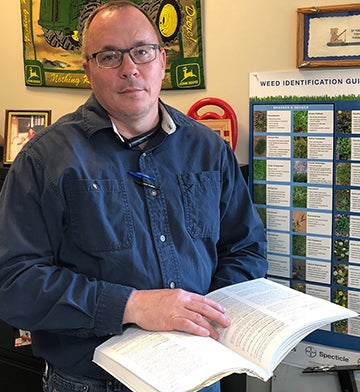Local crops hard hit by Hurricane Michael
Published 10:21 am Wednesday, February 6, 2019

- Bill Starr, Sumter County agent, for the University of Georgia Cooperative Extension Service, is shown in his office at the Sumter County Agricultural Office.
By Beth Alston
AMERICUS — Farming is already a risky business; it always has been. New technology has helped to give the American farmer an edge what with digital irrigation systems and planting tracks for tractors to follow. But that can be a double-edge sword — the tractors and harvesters of today are so complicated that not everyone can operate them; drones are being used more and more, and the investment is dear. But there are still farmers willing to take the risk, year after year, to eke a living out of the soil.
Bill Starr, Sumter County agent, University of Georgia Cooperative Extension Service, talked with the Times-Recorder recently about how the rains and winds of Hurricane Michael — which swept through portions of southwest Georgia in October 2018 — affected local farming operations.
Starr said the biggest loss for Sumter County farmers was for cotton growers, and was expected to be a great crop this year. “Prior to the storm, it was probably one of the best cotton crops I’ve ever seen,” he said. “It was amazing! The weather in September was really hot and we were getting moisture, so the cotton really filled out. … The yield potential was off the charts.”
Starr, who has been a county agent for 21 years, commented that the storm could not have come at a worst time.
He said that early on, just after the storm, loss estimates were 40 to 50 percent in some fields, but some cotton has not yet been harvested, so the final estimate is still unknown. He said the 40-50 percent estimate doesn’t include the quality losses due to weather and color changes, among other factors.
“Plus all the rain, almost continually,” since October, he said, has prevented many farmers from getting into their cotton fields to harvest. That results in the cotton “stringing,” making it difficult to pick. “You’re got a [picking] machine that weighs 70,000 to 80,000 pounds; the ground’s got to be pretty stable before you can get out there.” He said there are least 200 acres of cotton unharvested in Sumter County.
There was also damage to the local corn crop, according to Starr. Silage corn, which is used in making feed for cows, was damaged in an “usual” way, he said. The corn stalks weren’t merely blown down, but high winds tangled the stalks and then laid them down in different directions, “sort of like a checkerboard,” Starr said. “Extremely difficult to harvest,” he added, placing the amount damaged between 200-300 acres, at least. The harvest of grain corn was completed locally prior to the storm, he said.
Peanuts, big in this part of the country, suffered as well, but in a different way. Starr said that peanuts didn’t suffer yield loss as much as harvest delays, due again to the rains. Being that the peanuts grow underground, they fared better than other crops but still sustained some quality issues, with a loss of an estimated 10 to 15 percent. One of the potential problems late in the season for peanuts is that they start to sprout while still in the ground, and then you can’t harvest. “You’ve worked this hard,” Starr said, “and then this happens.”
Aaron Cosby farms land in southern Sumter County and northern Lee County. His father Julian Cosby also farms in that area. They grow peanuts, cotton, and green beans.
The younger Cosby said that before the hurricane, they had peanuts on top of the ground, plowed, and picked. “We were at 6,200 to 6,400 pounds per acre,” he said. They also had peanuts plowed up prior to the hurricane but unharvested. “They were 5,600 pounds to the acre,” he said. Once they got back into the fields after the hurricane and the crops had dried out, they picked again and were down to 4,200 pounds per acre. That’s a loss of some 2,000 pounds per acre from where they started to where they finished. He said the loss wasn’t due necessarily to the amount of rainfall, but to the “timing.” He explained: “The peanuts were mature and they were falling off the vine when we started picking a month later.”
Cosby said there were 21 straight days in October when the peanut picker sat under the shed because of rain and muddy field conditions. “It was just a disastrous season all the way through,” he said.
As for cotton, Cosby said they were picking 1,400 pounds per acre before the hurricane, and 408 pounds an acre after. “That’s a thousand pounds per acre [loss],” he said, “and you could see it on the ground after the hurricane.” He said they had cotton contracted that wasn’t at market price at the end of the year. “We had some 85-cent cotton contracted and we sold some of that, but we had unfilled contracts that would have helped out a good bit.”
His dad Julian said they have just finished everything up with the cotton crop for this year. “The seed is just no good,” he said, referring to the damage from the hurricane.
Cosby explained something that he says most people don’t understand about the local farming picture. “2016 was not that great a year. In ’17, we caught the edge of [Hurricane] Irma. There was actually disaster through here. In ’18, we had two, with Florence, the rain started beforehand, and then Michael came through. That’s three years in a row that we’ve been suffering … We’ve tried everything the past couple of years to try to quit falling behind. We’ve just decided to look for a narrower shovel so we don’t dig quit as deep a hole as this year. That’s the only thing we haven’t tried.”
Cosby said he went to Savannah recently to the fruit and vegetable growers convention, and someone asked what he was going to do differently. He said he told her that they were already doing everything as efficiently as they possibly could. She asked him again what he would change. He told her, “We’re going to do basically the same thing we did this past year. … That’s basically the definition of insanity — doing the same thing over and over and expecting a different result,” chuckling.
Cosby said his fall green bean crop would have been successful had the hurricane not come, but this too, was a double whammy. “In ’17, we had a problem with White Flies,” he said. “That was disastrous. It also hurt the cotton crop as well. But this last fall, it was an unbelievable [green bean] crop. This would have caught up with what we were carrying from ’16 and ’17, and we could have started ’19 on a fresh slate … Lots of folks are trying to decide what we’re going to do this year. You can’t it pencil out; it don’t work on paper. If it don’t work on paper, it dang sure ain’t gonna work in the field.” Cosby grows 50 acres of green beans, a spring crop and a fall crop. He said there are a couple of other farmers who grow upward of 100 acres. “We’ve been as high as 450 acres of beans in the past,” he said. “That’s too many. I’ve grown as much as 100 acres myself, spring and fall, but I’m down to 50 acres now. That’s five-week, 10-acre blocks; you get five weeks of exposure in the market. Hopefully if you start off in the $8 market you finish up on a $12, $15, $20 market.” He said that after Hurricane Michael, bean prices were up $30 per box, “because nobody had beans.”
But despite some previous disasters, the Cosby father and son are ready to start over again this year.
Another crop that sustained heavy losses is timber, Starr said, with 20 to 25 percent of pines damaged. Long-term problems can also come from trees being stressed during the storm which makes them more vulnerable to disease and insect infestation. “That’s kind of a one-two punch,” Starr said.
Another big crop in Sumter County is pecans, and they took a beating, too. “Pecan farmers suffered pretty significant losses,” Starr said. “Not only tree damage but trash that affects how the pecans are harvested. You have to have machines to get in there and wind row. When the nuts were blown down, when you’re wind rowing, you’re crushing a lot of the crop that’s already there.” Starr said that prior to the storm, Sumter County had the best pecan crop he had seen in a couple of years.
There is also a lot of livestock and milk production in Sumter. Starr said the area sustained “miles of fencing damage” due to the storm which allowed stock to wander.
Ken Daniel, a farmer in eastern Sumter County, who’s been at it since 1980, agreed to talk with the Times-Recorder about hurricane damage to his crops. He said his fall green (snap) bean crop, with 70 acres cultivated, was mostly lost. “With the rain and wind, it was totally wiped out,” he said. “It was just messed up. We harvested a few but they were so ugly looking, we just stopped harvesting.” He also said the bean losses impacted the cooperative packing sheds.
Daniel also grows cotton. He said he lost between 300 and 500 pounds per acre of the 246 acres he had planted. “It was not as big a hit as the people just south of us,” he said. “I had enough to pick and sell and get the cost back.”
Soybeans are another crop Daniel grows, and his crop was totally lost due to the storm. “We cut only 20 acres of the 146 acres planted,” he said. “It just kept raining and raining and raining. They sat in the hulls and rotted.”
According to the University of Georgia Center for Agribusiness & Economic Development, in 2017, Sumter County ranked fifth in the state for corn production in 2017, with 13,800 acres in cultivation for a Farm Gate total value of just over $10 million.
Sumter County ranked 22nd in the state for cotton production in 2017, with 25,000 acres cultivated and a Farm Gate value of over $17 million.
There were 18,015 acres of peanuts planted, with a Farm Gate value of almost $17.5 million. Sumter County ranked 18th in the state.
For silage corn, Sumter ranked fourth in the state with 6,500 acres in cultivation with a Farm Gate value of $9.3 million.
Sumter County ranked number two in the state that year for soybeans with 8,500 acres cultivated and a Farm Gate value of just shy of $3.5 million,
Sumter County ranked 15th in the state for pecan production with 3,500 cultivated acres and a Farm Gate value of about $8.3 million.
Snap beans in Sumter County, numbering 2,100 acres with a Farm Gate value of almost $5.5 million, ranked Sumter as number two.
Sumter ranked 58th in timber with a value of just over $4.5 million.



